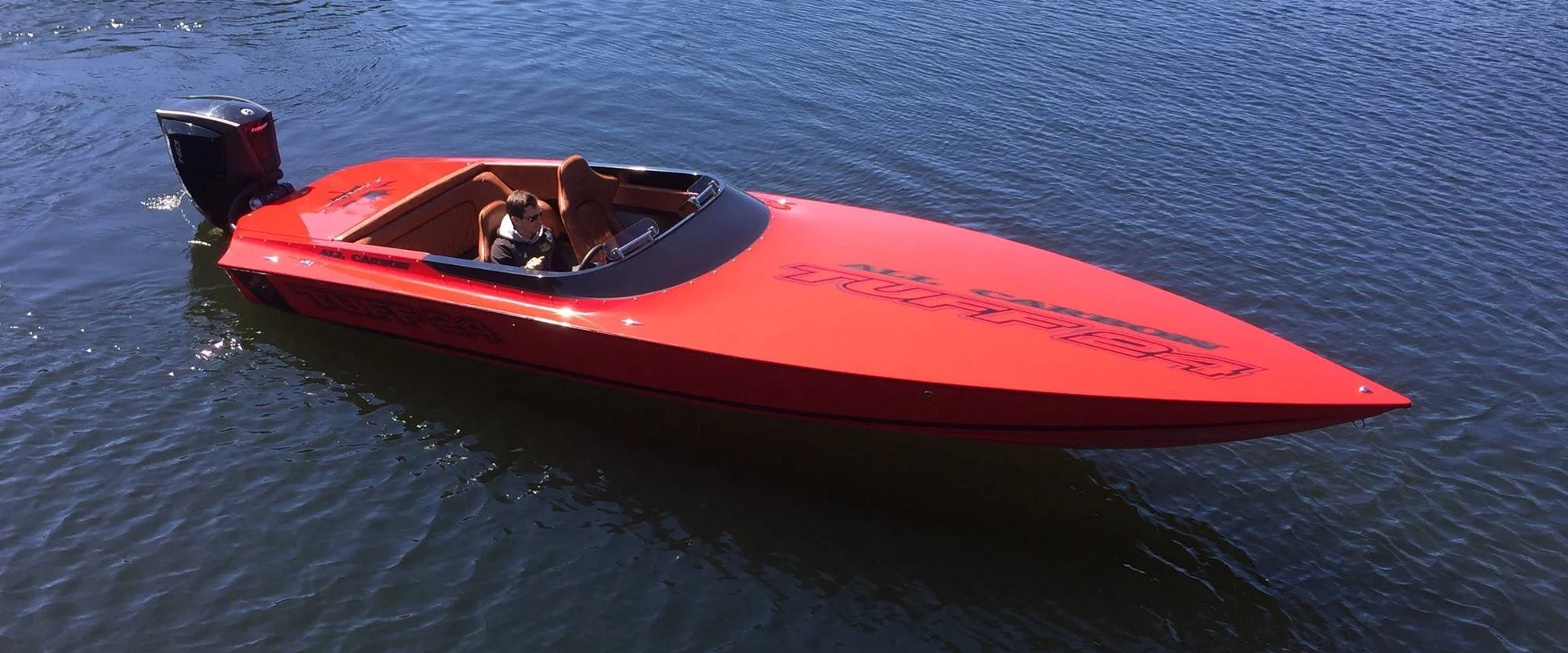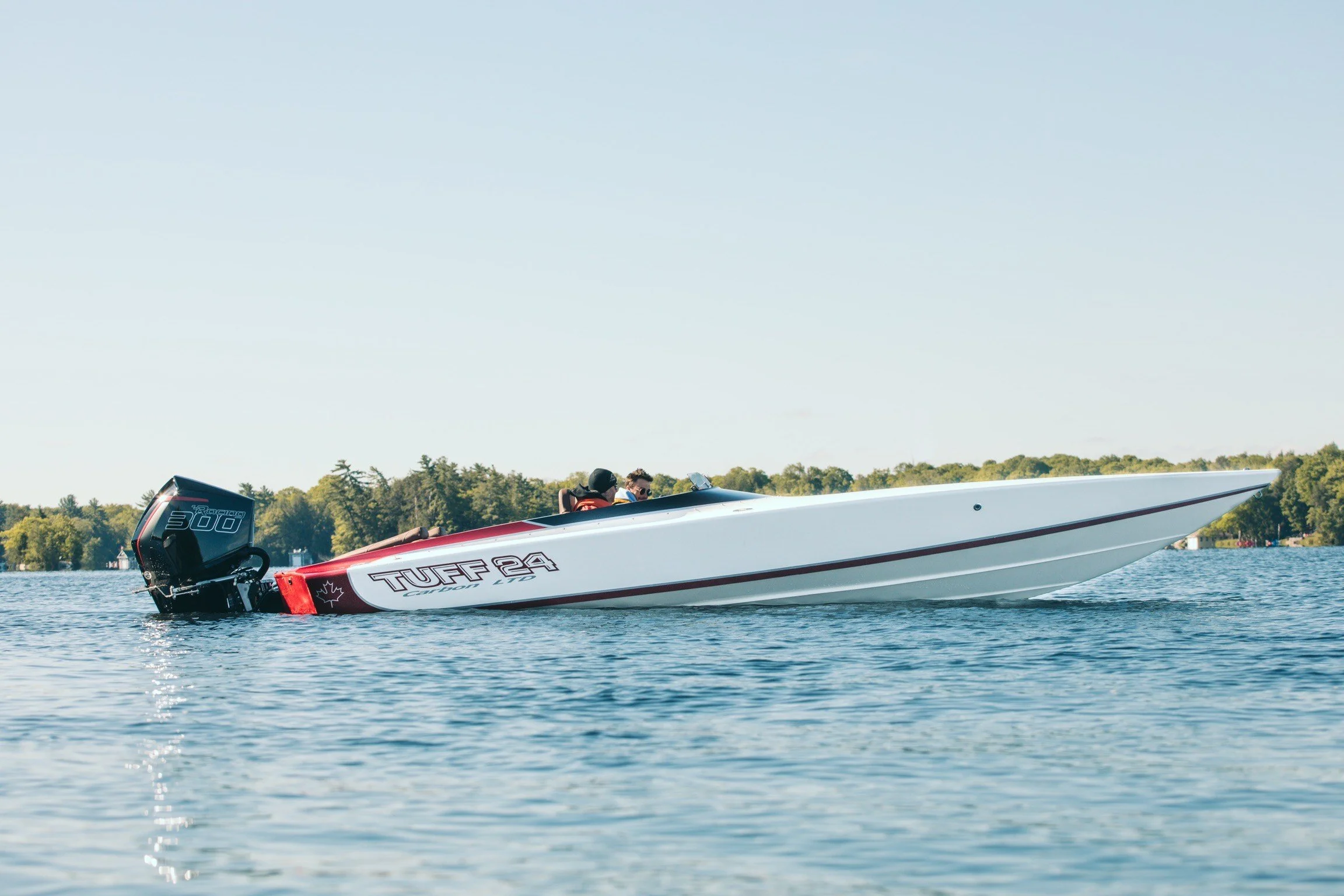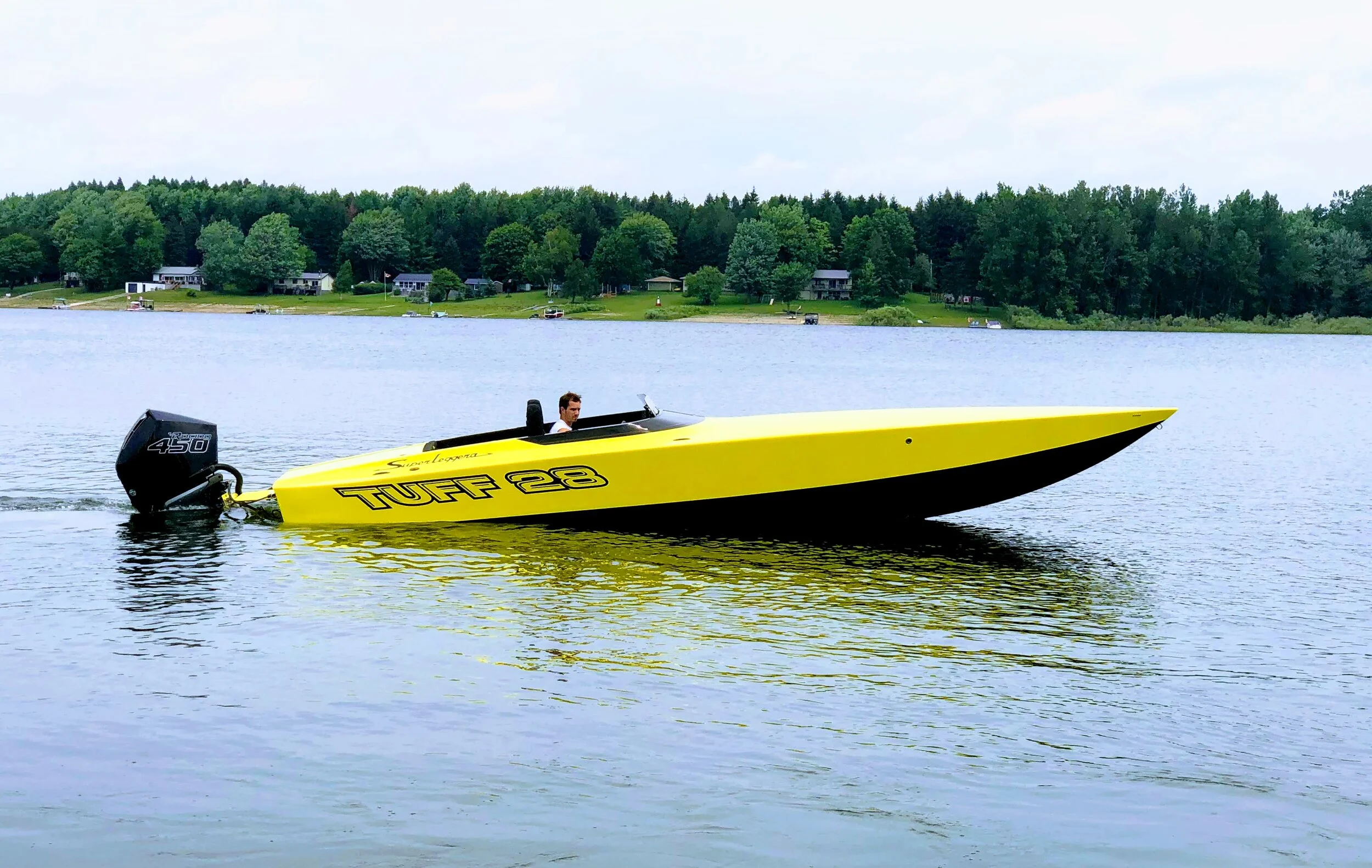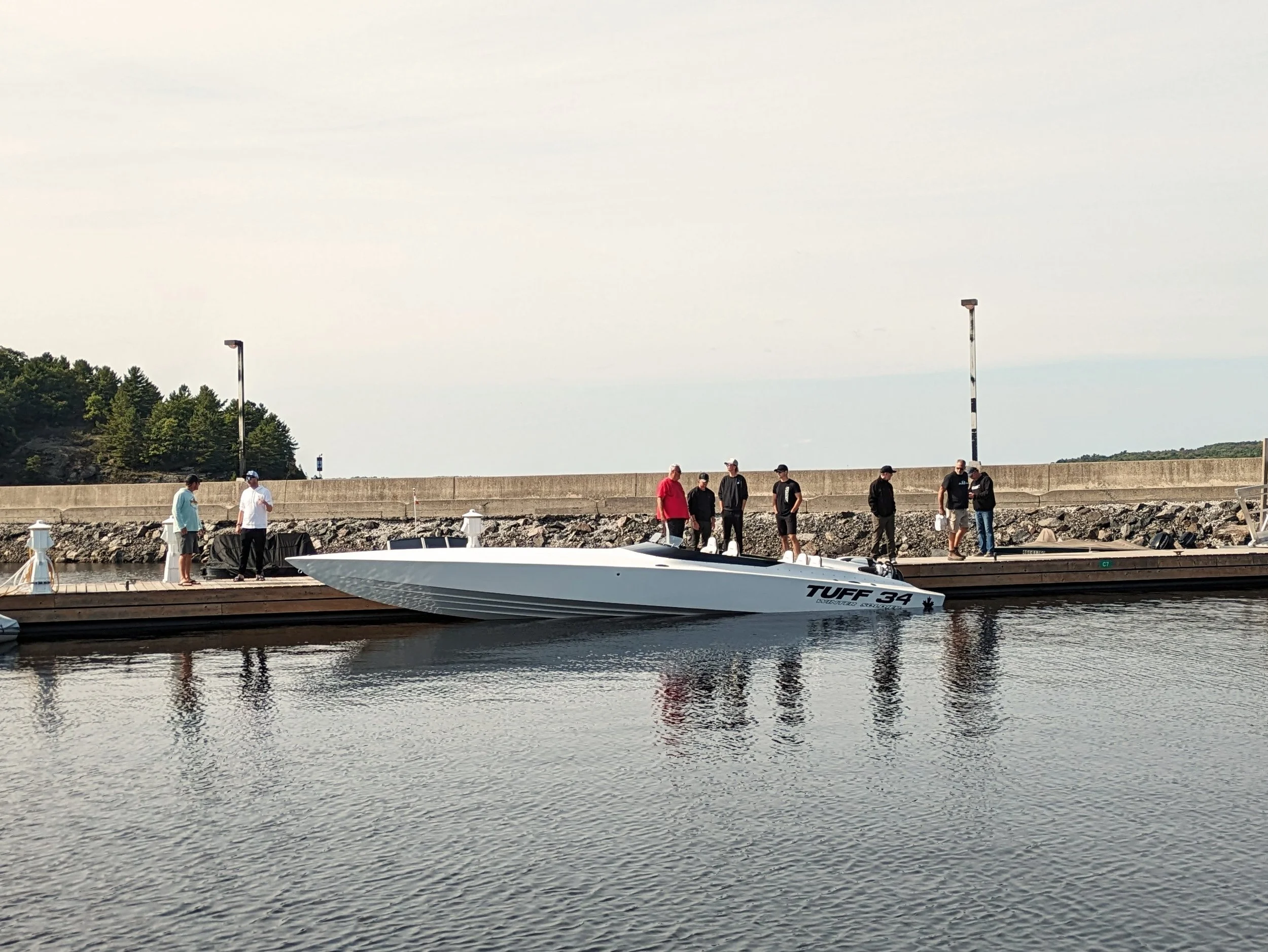10 Questions with Mark Weigl: Tuff Marine
In today’s world of performance boats and V-hull sport boats in particular, Tuff Marine has developed a reputation for building some of the fastest and well constructed custom boats you can find anywhere. Because they are made in Ontario, Canada and have a strong following there, very few boats have found their way south to the United States, although a few have and are true unicorn boats. I have seen the boats first hand at the Toronto Boat Show in the past and they live up to their reputation.
Racing
Mark and his wife in their 32 triple engine skater.
Founder, Mark Weigl began racing boats in the nineties With his wife. After racing with great success and poker run events, Mark decided to use his knowledge and experience to build custom performance boats and so in 2003, Tuff began. Starting with a 21 foot hull, which is a very popular entry level size, Mark started a following for his boat company. Mark’s 21 has its roots in the 21 Challenger design with hull and deck changes. The Tuff 21 does 106 MPH with a 300 XS. Following that, Mark designed from the ground up a stunning 28, which is among the fastest 28 foot V-hull boats out there, in outboard and sterndrive configurations. Mark then went after the small hot rod market with a beautiful 16 that does almost 60 MPH with a just a 60 HP and meets age restricted HP limits in Canada.
The Tuff 16 is an incredible little boat that has helped build the dedicated following Tuff Marine has. A gang of 16s seen here at a rally in Muskoka, Ontario, Canada.
Just last year, Mark brought another incredible hull to the market with the latest Tuff 24. I would say it is the perfect size single outboard considering today’s heavier more powerful outboards and its ability to take on any water conditions. I wanted to ask Mark more about the Tuff 24 design and a little about Tuff in general. He was very gracious with his time and offered some amazing insight, we really appreciate it. Here is the interview.
Who are you and how did you get into boating?
My parents were recreational boaters before my arrival, so I was always around boats and water. I had no interest in the consumer pleasure boats but when I saw performance boats I paid attention. In hindsight, all the radio control boats of my own design that I built should have been a clue to the future. Starting at 19, I raced modVP and then moved to Offshore. With racing success, my wife (driver) and I moved up in classes until we could no longer afford the costs of racing. Then I was at home cutting apart an old performance boat and was disgusted by how crappy you could build a boat and have it still function. That is when the idea of “what would a play boat run like that was built like my skater?” And so the boat building started.
What were your favorite boats growing up?
At 17 my first boat was a Hydrostream Vector with a 200, it was all the money I had and could borrow. I had no car, but I had a boat. That boat was the biggest acceleration from no real experience to fairly high performance boating and so it has great memories. One day some guys were doing a radar run in a quiet spot. They had a Challenger 21. I could not wait to show them that my Hydrostream was faster but it was not to be. The water had a little chop in it and I could not hang out the little boat. But the Challenger made pass after pass of poetry on water flying the bow and dancing on the choppy conditions. I remember how it would just hang there and glide so easy, it was a big impression.
How much have the materials and construction changed since the first Tuff?
The materials from the first TUFF boat to today are not that different. But the process of vacuum infusion today would be the biggest advancement. The other thing would be (quoting Mike D’Anniballe from Sterling Performance) “we are just taking care of the details.”
What was your philosophy and goals behind the 24 hull design?
With the advance of technology, the TUFF 21 got faster and faster. So we knew from racing that a bigger boat close to the same weight was always better than the smaller one with the same HP. Again, starting with the 28, we cut it down and made the TUFF 24. Bigger, safer and better at everything. The 24 has the best bottom design we have ever done. We also made it narrower so it has a smaller hole to punch through the air. Being longer it has a better aspect ratio. And so it finds itself to be a little faster than the TUFF 21 as well.
The Tuff 24 has beautiful proportions, with it's long deck and narrow 7' beam.
If you were setting up your own personal Tuff 24, how would you lay it up, which engine would you choose and how would you equip it?
Our last personal demonstration TUFF 24, and next year's demo boat are the same. All carbon fiber and using the Evinrude 300 (last years was the 250HO). There will be some more details to take care of, but we are looking to pull off a bragging rights number next year.
What did racing teach you about building boats?
Racing experience makes one a better set-up guy and should give you a better appreciation of wrecking stuff.
You see quite a few stepped hulls these days, even in non-performance hulls, Tuff does not utilize steps. What is your take on the advantages and disadvantages of steps in the 24 to 28 size range?
The step bottom design in Vee bottoms has its place, but in a contest of top speed at very high speeds, you cannot beat the pad bottom. When running correctly the steps that would have been in the boat would be in the air anyway. Instead of pushing a lubricated bottom through the water, we are flying above it. The design approach requires a driving skill. Some people have no interest in learning it and others love the experience of flying a Vee. We could make a rough water wave killer Vee bottom but why? There are lots of them out there, so we seem to be in the “worlds fastest in category” game of Vee bottoms.
Mark's Tuff 28 recorded a 117 MPH pass at LOTO in 2016, further adjustments have it at 121 MPH with an Ilmor 725. I believe that is the fastest single engine 28 V-hull out there.
Does Tuff plan on any other new models in the near future?
The next TUFF boat will probably be a TUFF 32. The point of the 32 would be to have something like a single Merc 1350 in it and run somewhere between 140 to 150 MPH. Or it would be a good platform for twin Mercury Racing 400s.
Any plans to market Tuff more in the USA or bring one to a boat show?
We are actually so busy right now, over a year waiting list, we can't handle any more business anyway, so for now it will be status quo.
Do Canadians actually like Tim Hortons? (Tim Hortons is like the Dunkin’ Donuts of Canada.)
Tim Hortons, it seems to be a dietary requirement in Canada. There is one on every corner and always busy. There are empty Tim Horton’s cups piled in every public garbage can. I don't do coffee, but I like donuts, so I can be found there sometimes as well.
Carbon
Many of Tuff's hulls have been full carbon fiber but can be built almost any way you want, with vacuum infused cored hull, sides and deck. Serious knees and support in this 24 seen here. This one goes 98 MPH with an Evinrude 250HO.
An early Tuff 24 built with an Ilmor MV8 570. Faster than the 21 and designed off the ultra fast Tuff 28. With a narrow beam, pad hull, and excellent weight distribution, it reaches 110 MPH.
Incredibly popular in Ontario, Canada, Tuff has rallies and gatherings in the summer. Beautiful Lake Muskoka. A 28, 24 and a gang of 16s.
The Tuff 16 is a top performing small boat, about 60 MPH with a 60 and the same attention to detail seen in all Tuff Marine boats.
Mark used CAD to design the original 28 and used that to help lead the design of the 24. The 16 is inspired by the 28 design from an original CAD as well.















